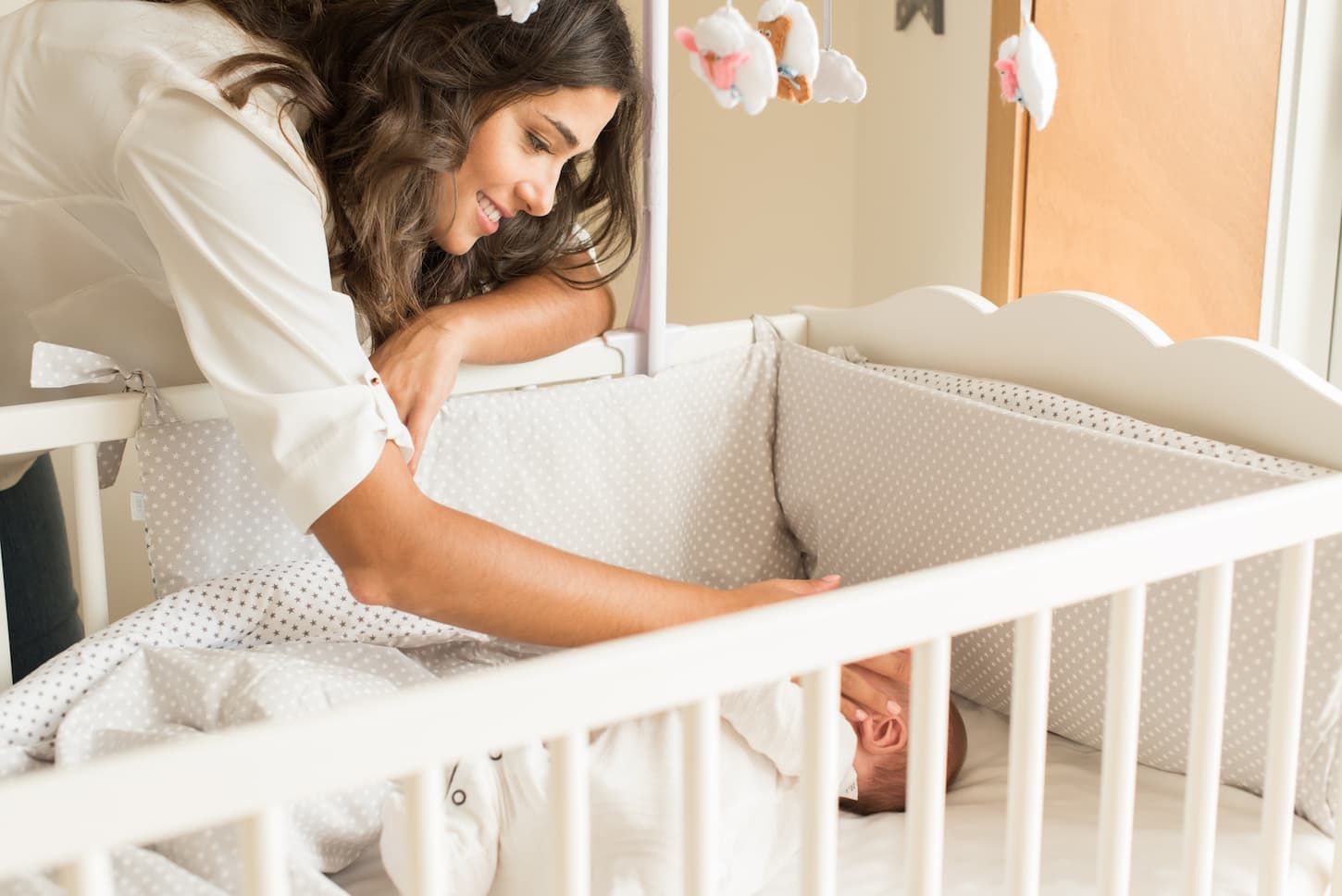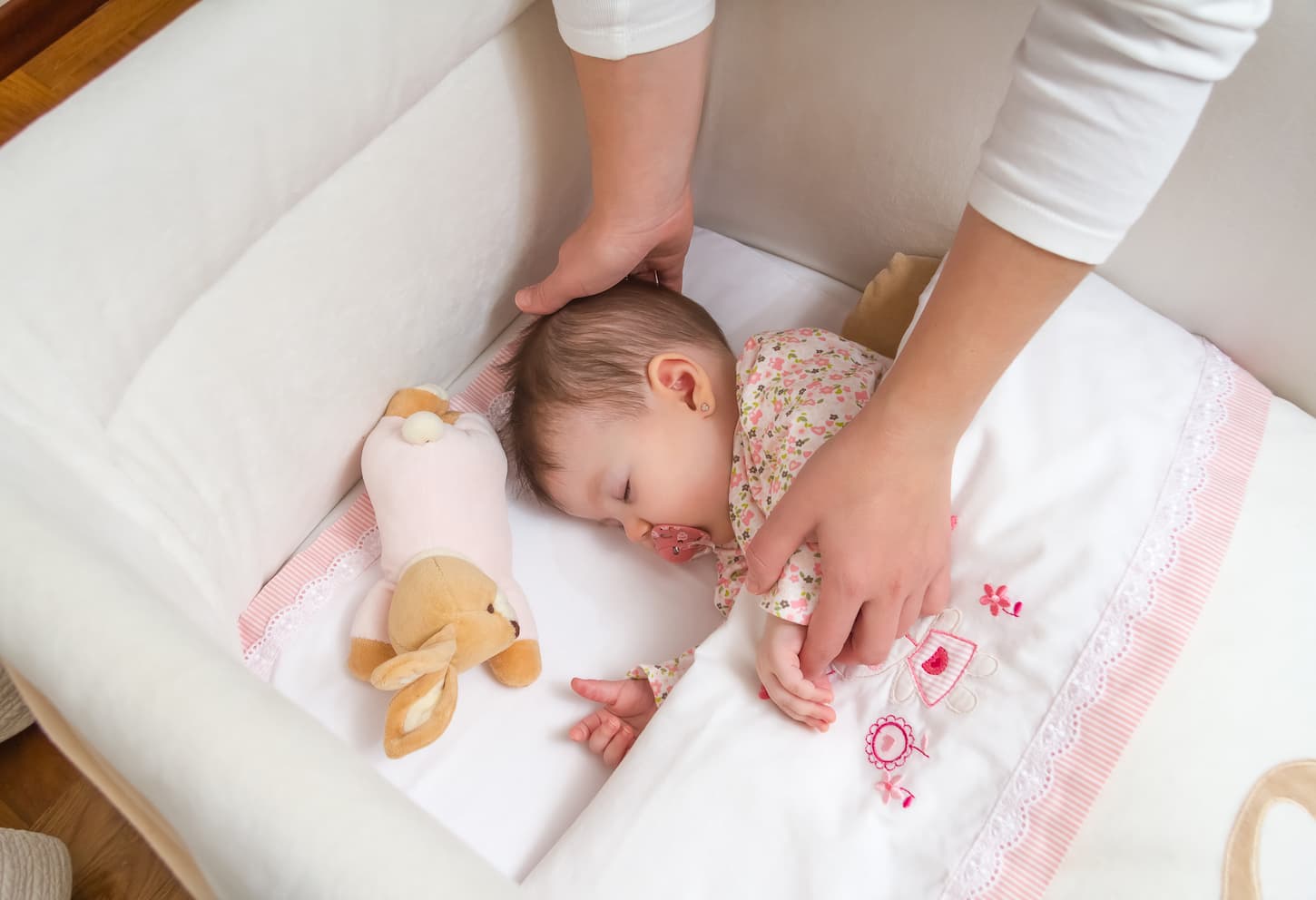Recently, a reader asked me for more ideas for gentle, tear-minimizing sleep training methods. Specifically, they wanted to know more about a particularly gentle and present style, so I did some research on the sleep training chair method. What is the chair method?
The sleep training chair method is a gentle, no-cry way to use both attachment parenting and sleep training. A parent sits on a chair next to the baby’s bed, providing support, until the baby falls asleep. Each night, the parent moves the chair further from the baby’s bed. Here is how it’s done.
Want to see if the chair method is the right choice for you and your little one? Here is how it’s done – and common questions about it answered by my research and parents who’ve used it successfully.

What is the Chair Sleep Training Method?
The chair method for sleep training isn’t difficult, but it will require you to be able to follow the plan strictly – and resist picking up your child. Thankfully, the plan is short. Ready for it?
Here’s the plan:
- Start by placing a chair next to your baby’s crib.
- Follow your regular bedtime routine.
- Plan on laying your baby down in the crib when they are drowsy, but not asleep.
- Once your baby is in the crib, plan to sit in the chair and be present for them until they fall asleep. You’re there for emotional support, but not physically comforting them.
The goal is for them to be able to be comforted enough that they’ll relax into sleep on their own.
However, keep in mind that you need to be moving the chair further and further away from their crib every few days. If you keep your chair next to them all the time, they’ll expect that to be the norm.
After a week or two, your goal is to be able to then lay your baby down and be able to walk out of the room.
Who Should Use the Chair Method?
The chair method is perfect for families who practice attachment parenting and/or want to limit the number of tears involved in sleep training. This method works best for families who have a bedtime routine in place and are patient – sitting in the baby’s room while they fall asleep may take a while!
So if you have a decently comfortable chair and some patience, this might be a great option for you. Just make sure your chair isn’t too comfortable – or you might fall asleep with the baby, too! If you do, no judgment from me – I’ve totally done that a few times. Luckily, it didn’t mess with the sleep training aspect too much.
When to Use the Sleep Training Chair Method
The chair method is a great choice if you’ve got time to sleep train – plan on it taking about two weeks to get to the point where you no longer need to sit in the room with your baby while they’re falling asleep.
If things aren’t progressing along at that particular pace, you may either want to adjust the method (knowing that doing so will slow the timeline down) or pick a different sleep training method. Click here to read our guide to the various behavior-based sleep training methods.
How Long the Chair Method of Sleep Training Takes
Ideally, this method should only take about two weeks for success. So here’s what that schedule might look like:
| Nights | Chair Location |
|---|---|
| 1-3 | Next to the crib with your hand on the baby while they fall asleep. |
| 4-5 | Next to the crib without touching the baby. |
| 6-8 | The chair is an arm’s length away from the crib. |
| 9-11 | You and the chair are two arms’ lengths from the crib. |
| 12-13 | The chair moves closer and closer to the door. |
| 14 | The chair is removed from the room before bedtime. You put the baby down to sleep at bedtime and walk right out of the room. |
If you do want to add any physical touch or reassurance into the plan (notice I did for nights 1-3), you’ll either need to build it into the plan and quickly phase it out or add a few nights onto the plan while you’re phasing it out more slowly.
Please keep in mind that slow change is the key to a tears-free sleep training method. So if you want fewer tears, you will need to go slowly. Even with this method!
What Age is this Gentle Sleep Training Chair Method Good For?
This can vary depending on your child, but most tend to do well once they reach about 4-6 months of age or older. Starting any sooner than that and you might have a bit of an issue, simply because younger babies rely so much on physical comfort.
If you find that you’ve started and it’s not going well with your child, talk to your pediatrician and see what they recommend. You may want to consider a different sleep training method – read our article on sleep training by age to find an age-appropriate method.
Should I Pick Up the Baby When Sleep Training with the Chair Method?
With the chair method, you’re not supposed to pick up the baby at all, no. You’re supposed to sit next to them and provide emotional support by sitting next to them.
If sitting next to your child doesn’t provide them the kind of support they want (in other words, it makes them scream like crazy because they want to be held), know you aren’t alone. And know that it’s also okay to adjust this sleep training method to better work for your family’s needs.
If you do need to pick them up, you can either pick a different method or you can build picking your baby up into this method. Let’s talk about customizing this plan next.
How to Adjust or Modify the Chair Method for Your Needs
As with any method, it’s totally fine to customize the plan to fit your family’s needs. So if your baby needs a few nights of being held with this method? Build that into the plan – and see how it goes.
In the worst-case scenario, things will absolutely not work – but you’ll have found something that didn’t work. And as long as you use that in your next attempt, it’s not a failure – it’s part of the learning process.
So if you want to build an extra few days into this method so that you can start by holding your baby while you’re both in the chair? Go for it. I’ve done it – and it can work.
After one bout with illness, I used a modified chair method with our daughter. The first few nights involved me holding her in the chair while she dozed off – and then I put her in the bed. The next few nights I lay next to her on the floor and held her hand. Then, I moved to the chair and slowly backed the chair away from her bed.
In that kind of scenario, it’s no longer the “pure” chair method. But who cares as long as it gets results, right? And if it’s what works for your family, it’s still very much a success story – even if you didn’t stick to a pure sleep training method.
It’s totally fine to take a commonly-used method and adjust it to meet your family’s needs. That way, it’s a customized sleep training plan – and far more likely to work.
Is the Chair Method Really Tear-Free?
Truth be told, there might be a bit of crying (or at least whimpering) involved no matter what type of sleep method you try. The key to having little to no tears is to be consistent in your efforts while also meeting your child’s basic needs.
The great thing about this sleep training method is that you’re still there for your baby, so the risk of tears is lowered greatly. And the slower that you go with sleep training, the risk of tears continues to decrease.
So if you want to make this a tears-free sleep training method, you can. Just go slow – maybe even slower than the recommended two-week timeline for this method.
Many parents are able to sleep train – with this method – without any tears at all. I surveyed parents who have used this method. It’s not a super common method, but it is used. Parents recommend using gentle physical touch and comfort at first – and then slowly adding physical distance to transition from physical comfort to emotional support.
If you’ll refer to the example timeframe (in the table) earlier in the article, I’ve built the recommendations into the two weeks to sleep training success with the chair method. Just refer to that.

Other Chair Method Sleep Training Recommendations
While you’re sitting there in the chair, make sure you don’t fall asleep, too. Have something to do that’s engaging enough for you to stay awake – but doesn’t require lights or sounds that might wake up your baby.
I’ve loved having audiobooks to listen to – so that I’m not having to rely on any lights to read – and having the headphones means I’m not disrupting my falling-asleep child. Here are my book recommendations for sleep-related topics.
Or if you’d rather read (okay, listen to) actual books, go for it – download something awesome on your Audible account and listen. Don’t have an Audible account? Use this link to get a free, 30-day trial Audible account via Amazon.
Oh, and don’t forget to make sure that your child’s bedroom is set up for sleep training success – this has been our favorite white noise machine for our children (click here to see pricing on Amazon). To read why we love that model – and find out what other bedroom gear is a must, click here to read my bedroom gear recommendations.